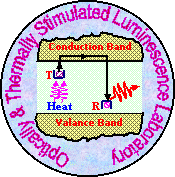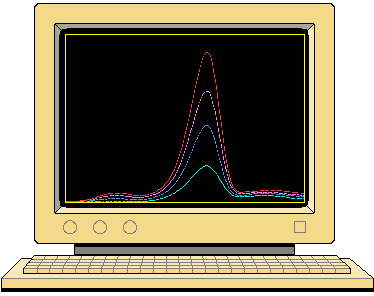Question:
If a TLD is exposed to a light bulb or a bright flash such as that
from a camera, is that exposure equivalent to some gamma ray exposure which
is above the regulatory limit?
Answer:
If you expose a bare TL element, such as LiBO or CaSO (Panasonic TLD)
or LiF, CaF (Harshaw TLD), there will be some uniform response that will
be assumed to be a high energy photon response. This usually results in
20 to 50 mrem per month of "assumed" dose. If the TL element is exposed
longer, the response will increase. There is also a fade that occurs, so
with the increasing response there is also fading occurring. Therefore
is no finite equation to be used to eliminate what is real and what is
not real dose. In conclusion, the response will NOT exceed regulatory limits,
be they quarterly or annual limits (NRC or state) or for declared pregnant
females (500 mrem gestation period)..
Question:
What is the difference between Electronic Personal Dosimeters and TLDs?
Answer:
There are many differences. Each dosimeter has its own characteristics,
and needs to be dealt with independently, even in the manner in which they
are calibrated. Some thoughts:
(1) The TLD accumulates dose from the time it is annealed, prior to
shipment, until the time it is processed (heating to 300 degrees C). Therefore,
all exposure, occupational, natural background and transit dose (higher
natural background) is accumulated. The Control Badge is used to define
what is natural and not occupational dose, and is then used to report the
net dose on the personnel dosimeter.
The EPD only measures exposure while the unit is on.
(2) The TLD uses an algorithm that allows the device to measure and
report dose for all types of radiation, i.e., gamma, beta, x-ray and neutron,
and, dose ranges based on specific methods of calibration.
The EPD is generally calibrated to Cs-137, and highly under-responds to
much higher energy photons and low energy x-rays, and will not respond
to beta (unless you have Siemens or perhaps, the new MGP EPD). In any event,
the SDE is not as accurate as the DDE.
When a facility is in an outage, and there is much work performed in
high energy photon araes, where the average energy is around 1 MeV (due
to Co-60), the TLD is highly accurate, where the EPD will under- respond
to this high energy photon component, by ~ 10 to 15%. This causes the TLD
to report a higher dose than the EPD. It is very important to know the
fileds one has worked in when attempting to compare a TLD / EPD ratio.
(3) Many calibrate their EPD to match the TLD. This is not a correct
method. They act characteristically different, and need to be assessed
differently. Many EPDs have set points, and how these are manipulated determines
how the EPD reports dose. The EPD generally estimates a dose rate and then
converts to a cumulative dose reading. If there is a spike in the reading,
there may be the potential for an over-response for the cumulative dose.
(4) TLD / EPD correlations. The TLD only reports dose > MRD, and in
ICN's case, as is the industry standard, we report dose > 10 mrem. The
EPD generally measures dose rate in 0.1 mr/hr (so they say) and will report
a 1 mrem cumulative dose. The real issue is in how the facility issues
and reads EPD dose for personnel. Do you give a person an EPD and they
wear it for the whole day, a certain time period, or do they exchange for
a different EPD on each entry into the radiation controlled area? If there
is a new EPD used for each entry, there is the issue of EPD accuracy and
precision, and, the small incremental dose that is received, and rounded
up on each entry. This could lead to higher EPD over-response.
(5) The EPD is susceptible to external factors, such as RF, cell phone
etc. These do cause spikes in many EPDs used in the power reactor world.
This is getting better, but not there yet.
(6) The TLD using LiF is tissue equivalent. Therefore, the dose is
easier to measure and report. The EPD is not tissue equivalent, and is
only as good as the source used to perform the calibration. As individuals
move through the plant, they are exposed to all kinds of radiation, and
energies, due to primary and scattered radiation. The TLD algorithm accommodates
this. The EPD can not, and will assume all response due to Cs-137 equivalent
energy, 0.662 MeV. All of the low energy x-ray will under-respond, and
the high energy gamma, > 0.662 MeV will under-respond. How the TLD / EPD
ratio works at the end of a monitoring period is dependent on these mixtures
and time frames of exposure.
(7) The EPD is highly geometry dependent, and the batteries do skew
the data sometimes. The TLD is more tolerant to geometry, and is not nearly
as much a problem.
Question:
How Long can I wear my Film or TLD Dosimeter?
Answer:
The laboratory has collected test and operational data on several dosimeter
types with view toward evaluating the maximum wear period feasible without
significant degradation of accuracy or precision.
In the case of film dosimeters, corrections are applied based on measured
emulsion and processing batch specific characteristics. Some of these include
contrast, film speed, background accumulation, and dose/response characteristics
over the range of background to 500 R. By application of these correction
factors, the laboratory has determined that their film dosimeters have
a practical useful life of up to 9 months. The maximum useful deployment
time for the film dosimeter has been administratively set at 6 months.
Dosimeters returned for processing after these times are read, but the
results are reported as "outdated badge - no evaluation made" or as an
"estimate only", depending on the wishes of the customer.
For Bicron/Harshaw TLDs, fade is normalized to ±7 days of the
irradiation date. The maximum useful deployment time for the Bicron/Harshaw
TLDs has been determined to be 1 year. Fade for the Panasonic TLDs is normalized
to 24 hours post irradiation. The maximum useful deployment time for the
Panasonic dosimeters has been set at 6 months. Dosimeters returned for
processing after these times are read, but the results are reported as
"outdated badge - no evaluation made" or as an "estimate only", depending
on the wishes of the customer.
"Fading of TLD materials under normal conditions of use, is documented
and accounted for over the intended period of use...." In order to provide
good customer service, dosimetry testing facilities should collect data
over a period of time beyond the intended period of use because there will
be wearers who turn in their dosimeters late. A rule of thumb used by most
dosimetry testing labs is to characterize the fading characteristics of
their TLDs for twice the intended wear period.
Question:
What type of Dosimeter is best for Nuclear Medicine Departments?
Answer:
We have determined from a very detailed review of the dosimeters used
during the three month period in your Nuclear Medicine Section that due
to the range of energies and angles that strike the film badge, the algorithm
appears to be believe that the field is a mixture of high energy X-rays
and gamma rays. Although this may model the apparent energy, the filter
pattern on the developed film also indicates a very blended filter pattern,
which in turn makes it somewhat difficult to provide standard filter pattern
for the determination of the optical densities. This blending of the filters,
and the wide range of energies which may strike the badge from a multitude
of angles, causes an overestimation of the exposure.
Thermoluminescent dosimeters do not demonstrate this type of blending;
therefore we believe that for the Nuclear Medicine Section the TLD badge
provides a more accurate determination of the exposure
Question:
Is it possible to use TLD for high range doses?
Answer:
ICN Worldwide Dosimetry Service has developed a High Range TLD
Dosimeter capable of measuring high-energy photon doses to 1 kGy. Additional
correction factors have been established for as many as 10 various x-ray
and beta sources, allowing for high range monitoring of other sources and
energies from 500 to 1,000 Gy. The product utilizes TLD-100 chips, available
in three different configurations of very small size, and is offered at
an economical price. Data analysis is quick, providing results within 24
hours in most cases. This report describes the testing completed to support
this product; primarily the determination of the supralinearity corrections
necessary for doses up to 1 kGy.
|

